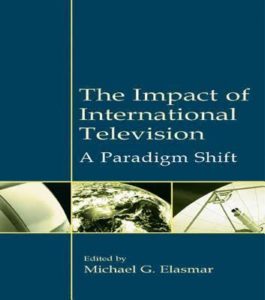Books:
 |
Elasmar, M. G. (2008). Through their eyes: Factors affecting Muslim populations’ support for the U.S.-led war on terror. Spokane, WA: Marquette Books.
Summary
Following the terrorist attacks on the United States of 9/11/01, the U.S. Government declared a global war on terror. Simultaneously, there was an urgent need for an explanation for the hatred that triggered these attacks. In an attempt to find such an explanation, researchers, policy-makers, and U.S. government officials turned to international public opinion polls to uncover the general attitudes of populations abroad toward the United States. These descriptive public opinion polls showed a generally negative attitude of Muslim populations abroad toward the United States and the U.S.-led war on terror. As a result, the U.S. Congress began seeking the advice of international experts to determine what can be done to change the detected negative public opinion patterns. While the recommendations made by experts were plentiful, there was no objective mechanism for prioritizing certain recommendations over others. In order to truly determine what needs to be done, researchers need to first understand how the United States and the U.S.-led war on terror are perceived in the minds of Muslim individuals living abroad.
Understanding perception, in this context, … more
|
 |
Elasmar, M.G. (2003). (Ed.). The impact of international television: A paradigm shift. Mahwah, NJ: Lawrence Erlbaum Associates, Inc., Publishers. |
Articles:
Elasmar, M. G. & Groshek, J. (2017). A historical overview and future directions in the conceptualization of country images. In J. A. Fullerton and A. Kendrick (Eds.), Shaping International Public Opinion (pp. 27-38). New York, NY: Peter Lang.
Groshek, J., Guo, L., Cutino, C. & Elasmar, M. G. (2017). A sample methodology for extracting and interpreting country concept from social media users and content. In J. A. Fullerton and A. Kendrick (Eds.), Shaping International Public Opinion (pp. 77-94). New York, NY: Peter Lang.
Elasmar, M.G. (2017). Cross-border mediated messages. In L. Cheng, (Ed.). Intercultural Communication (pp. 503-528). Berlin, Germany: De Gruyter Mouton.
Wu, H. D., Groshek, J., & Elasmar, M. G. (2016). Which countries does the world talk about? An examination of factors that shape country presence on Twitter. International Journal of Communication, 10, 18. Retrieved from http://ijoc.org/index.php/
Elasmar M. G. (2011). Intercultural media effects (An update). In Wolfgang Donsbach (Ed.), International Encyclopedia of Communication. Oxford, England: Blackwell Publishers Ltd.
Elasmar, M. G. (2010, September). A review of media choice. European Journal of Communication, 25, 296-298.
Elasmar, M. G. (2009). The need for theory and its role in understanding international public opinion about people belonging to other religions. In A. MacDonald-Radcliff & R. Schatz (Eds.), Annual Dialogue Report on Religion and Values. Zurich, Switzerland: InnoVatio.
Elasmar, M. G. (2007). Intercultural media effects. In Wolfgang Donsbach (Ed.), International Encyclopedia of Communication. Oxford, England: Blackwell Publishers Ltd.
Elasmar, M. G. (2006). Investigating the influence of U.S. television abroad: The case of adolescents in Morrocco. Feedback, 47(5), 4-16.
Elasmar, M. G. & Bennett, K. (2003). The cultural imperialism paradigm revisited: Origin and evolution. In M. G. Elasmar (Ed.), The Impact of International Television: A Paradigm Shift (pp. 1-16). Mahwah, NJ: Erlbaum Routeldge.
Elasmar, M. G. & Hunter, J. E. (2003). A meta-analysis Of crossborder effect studies. In M. G. Elasmar (Ed.), The Impact of International Television: A Paradigm Shift (pp. 133-154). Mahwah, NJ: Erlbaum Routeldge.
Elasmar, M. G. (2003). An alternative paradigm for conceptualizing and labeling the process of influence of imported TV programs. In M. G. Elasmar (Ed.), The Impact of International Television: A Paradigm Shift (pp. 157-180). Mahwah, NJ: Erlbaum Routeldge.
Elasmar, M. G. (2003). The impact of international audio-visual media: An expanded research agenda for the future. In M. G. Elasmar (Ed.), The Impact of International Television: A Paradigm Shift (pp. 181-190). Mahwah, NJ: Erlbaum Routeldge.
Aoki, K. & Elasmar, M. G. (2000). Opportunities and challenges of web surveys: Results of a field experiment. Proceedings of the American Statistical Association. Alexandria, VA: ASA.
Elasmar, M. G. (1999). The opportunities and challenges of using meta-analysis in the field of international communication. Critical Studies in Mass Communication, 16 (3), 379-384.
Elasmar, M. G., Hasegawa, K. & Brain, M. (1999). The portrayal of women on prime time TV programs broadcast in the United States. Journal of Broadcasting and Electronic Media, 43 (1), 20-34.
Elasmar, M. G. & Hunter, J. (1997). The impact of foreign TV on a domestic audience: A meta-analysis. Communication Yearbook 20, 47-69.
Elasmar, M. G. & Carter, M. (1996). Uses of email by college students and implications for curriculum. Journalism & Mass Communication Educator, 51 (2), 46-54.
Elasmar, M. G. (1995). The direct broadcast satellite industry in the U.S.: Development and economic concerns. Journal of Broadcasting and Electronic Media, 39, 200-214.
Elasmar, M. G. (1993). DBS! But is it viable? Satellite Communications. 17 (7), 3A-7A.
Elasmar, M. G. & Straubhaar, J.D. (1993). Selective exposure to television news sources during the Gulf War. In B. S. Greenberg & W. Gantz (Eds.), Desert Storm and the Mass Media. Cresskill, NJ: Hampton Press.
Elasmar, M. G. (1993). Assessing videotex diffusion and usage patterns in a manufacturing organization. In J. G. Savage & D. J. Wedemeyer (Eds.), Proceedings of the Pacific Telecommunications Council. Honolulu, HI: Pacific Telecommunications Council.
Elasmar, M. G. (1991). Direct broadcast satellite (DBS) in the U.K. Satellite Communications, 15 (5), 19-21.
Steinfield, C. & Elasmar, M. G. (1991). Business use of videotex: The added value of the national infrastructure. In D. J. Wedemeyer & M. D. Lofstrom (Eds.), Proceedings of the Pacific Telecommunications Council. Honolulu, HI: Pacific Telecommunications Council.